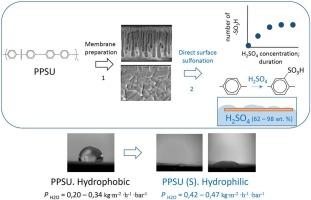聚苯砜基多孔膜的后磺化亲水性研究
IF 5.1
3区 工程技术
Q1 CHEMISTRY, APPLIED
引用次数: 0
摘要
聚苯砜(PPSU)具有良好的力学性能和水解稳定性,是一种有吸引力的膜材料;然而,它的半疏水性通常导致低水渗透率。在这项工作中,我们首次提出了一种通过后磺化制备不对称PPSU膜的亲水性方法。这种方法可以制造具有预定参数的膜,然后通过控制后处理条件来调整其亲疏水平衡。相比之下,PPSU聚合物的事先磺化(一种常用的方法)需要修改浇注条件,因为磺化程度的变化会改变聚合物的溶解度参数,并影响通过非溶剂诱导相分离(NIPS)工艺形成的膜的性能。磺化剂为硫酸水溶液(62% ~ 98% wt%),处理时间为1 min ~ 20 d。研究了商业(BASF)和内部合成的PPSU样品。磺化作用显著降低了水接触角:致密膜的水接触角从89 ~ 92°降至0°,多孔膜的水接触角从67 ~ 69°降至44 ~ 50°。因此,磺化后的PPSU膜的透水率从0.20 ~ 0.34增加到0.42 ~ 0.47 kg/m2·h·bar,大约增加了一倍。值得注意的是,最大化原始膜的透水性(通过使用成孔剂等)超出了本研究的范围。该膜对蓝葡聚糖染料(MW 70000 g/mol)的去除率高达99%。膜中残留的NMP溶剂也可能发生磺化反应。本文章由计算机程序翻译,如有差异,请以英文原文为准。

Hydrophilization of porous membranes based on polyphenylene sulfone by post-sulfonation
Polyphenylene sulfone (PPSU) is an attractive membrane material due to its good mechanical properties and hydrolytic stability; however, its semi-hydrophobic nature typically results in low water permeance. In this work, we propose, for the first time, a method for the hydrophilization of fabricated asymmetric PPSU membranes via post-sulfonation. This approach allows the fabrication of a membrane with predetermined parameters, followed by tuning of its hydrophilic/hydrophobic balance by controlling the post-treatment conditions. In contrast, prior sulfonation of the PPSU polymer (a common method) necessitates a revision of casting conditions, as varying the degree of sulfonation alters the polymer solubility parameter and affects the properties of the membrane formed via the non-solvent induced phase separation (NIPS) process. Aqueous sulfuric acid solutions (62–98 wt%) were used as the sulfonating agent, and the treatment time was varied from 1 min to 20 days. Both commercial (BASF) and in-house synthesized PPSU samples were studied. Sulfonation significantly reduced the water contact angle: from 89 to 92° to 0° for dense films, and from 67 to 69° to 44–50° for porous membranes. Consequently, the water permeance of the sulfonated PPSU membranes approximately doubled, increasing from 0.20 to 0.34 to 0.42–0.47 kg/m2·h·bar. It should be noted that maximizing the water permeance of the pristine membrane (by using pore-forming agents etc.) was beyond the scope of this study. The membranes demonstrated a high rejection rate of 99 % for Blue Dextran dye (MW 70,000 g/mol). It was proposed that the residual NMP solvent in the membrane might also undergo the sulfonation.
求助全文
通过发布文献求助,成功后即可免费获取论文全文。
去求助
来源期刊

Reactive & Functional Polymers
工程技术-高分子科学
CiteScore
8.90
自引率
5.90%
发文量
259
审稿时长
27 days
期刊介绍:
Reactive & Functional Polymers provides a forum to disseminate original ideas, concepts and developments in the science and technology of polymers with functional groups, which impart specific chemical reactivity or physical, chemical, structural, biological, and pharmacological functionality. The scope covers organic polymers, acting for instance as reagents, catalysts, templates, ion-exchangers, selective sorbents, chelating or antimicrobial agents, drug carriers, sensors, membranes, and hydrogels. This also includes reactive cross-linkable prepolymers and high-performance thermosetting polymers, natural or degradable polymers, conducting polymers, and porous polymers.
Original research articles must contain thorough molecular and material characterization data on synthesis of the above polymers in combination with their applications. Applications include but are not limited to catalysis, water or effluent treatment, separations and recovery, electronics and information storage, energy conversion, encapsulation, or adhesion.
 求助内容:
求助内容: 应助结果提醒方式:
应助结果提醒方式:


